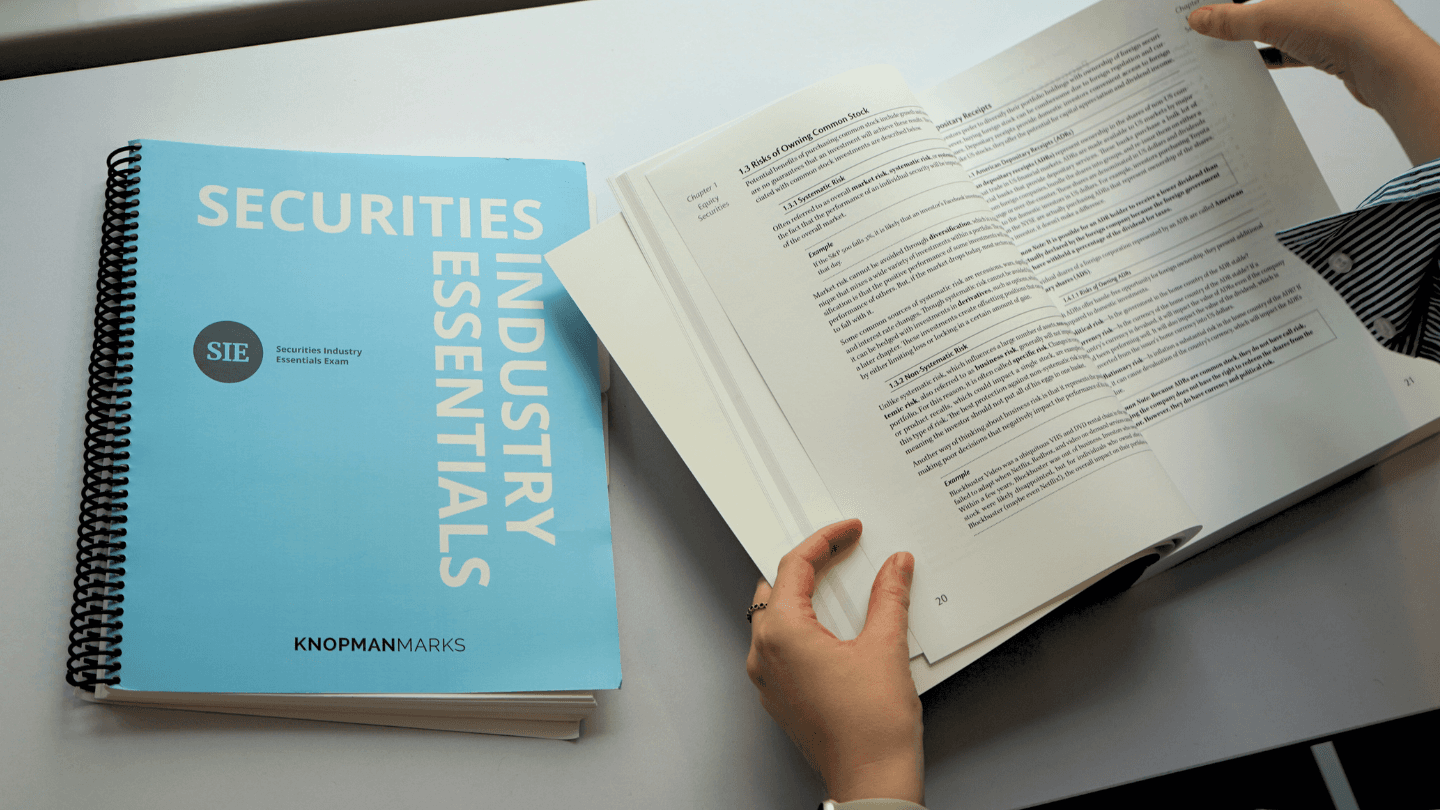
Welcome to our free equity review! I’ve put together for you the full first lesson that we cover in our SIE exam prep course. What I hope to do is give you a sense of what the Knopman Marks program looks like and feels like, as well as show you how using our process will help you learn and master the content needed to pass your exam. To get the most from your time – and to more closely replicate the Knopman Marks study process – be sure to download the PDF slides to jot notes on while watching and listening to the video lesson.
Here’s an overview of what you will see in this lesson.
Equity Lesson Goals
- Review and define common stock, preferred stock, rights, warrants, and ADRs.
- Understand the rights, features, and risks of these instruments.
- Describe the dividend payment process and its sequence of events.
- Calculate an investor’s position after a stock split or stock dividend.
- Understand short sales and their objective.
Key Equity Lesson Concepts
Understanding the different types of equity securities is important for passing the SIE Exam. Below is an overview of the types of securities discussed in the first lesson.
Common stock—An equity security that represents ownership, giving investors a claim on the company’s assets and earnings and offering the potential for growth (capital gains) and/or income (dividends) is referred to as common stock. For exam purposes, common stock is an asset generally appropriate for investors with a higher risk tolerance or longer time horizons, even though there is a wide range of riskiness within common stock ownership.
Preferred stock—An equity security that represents ownership that is senior in priority to common stock is called preferred stock. It pays a regular, fixed dividend payment. For exam purposes and particularly while focusing on suitability, consider preferred stock for investors seeking higher levels of current income than fixed-income products (such as bonds or notes) can provide. Accordingly, investors should acknowledge that those higher returns come with higher levels of risk (such as missed or skipped dividends) and a lower position in the event of a liquidation or bankruptcy, as compared to debt holders (though preferred is above common stock in priority).
Rights—Rights allow shareholders to buy shares to maintain their proportionate ownership in the company if the company issues additional shares. For exam purposes, always make sure clients are aware of rights that have been issued so that they can capture the inherent value in the instrument by 1) purchasing the new shares being offered or 2) liquidating (selling) the right instrument to another investor. Rights, as a general matter, should not be ignored or left to expire.
Warrants—Warrants give an investor the ability to purchase a company’s stock at a fixed price for a set period of time (typically a long time period, such as 5 years, 10 years, etc.). In general, warrants are issued by the company when it is offering another security to make that security more attractive. On the exam, warrants offer investors two potential returns (e.g., a company will issue bonds or preferred stock, and purchasers of the bond or preferred will also be issued a warrant). For the exam, warrants can generate returns for investors in two ways: 1) the warrant can be sold, or 2) the warrant can be exercised and allow the purchase of common stock at a below-market price.
Download Your Free SIE Practice Question Set
American depositary receipts (ADRs)—ADRs offer investors the ability to get equity exposure (think common stock) to a foreign company but remain in the US markets. For example, a European company looking to raise US equity capital could sell ADRs in the US, and US investors would buy and trade the ADR, while European investors could buy and trade the common stock in the issuer’s home country. For exam purposes, think of ADRs as being just like common stock, but with the added risks of international politics and currency risk.
Dividends—Distributions of a company’s profits to shareholders, dividends are generally paid in cash or in additional shares of stock and must be declared by the company’s board of directors. To receive a dividend, an investor must own the stock on the ex-date (described and defined in the video lecture).
Stock split and reverse stock split—Splits result in an artificial adjustment of a company’s stock price and number of shares, with no actual change to the total value of the issuer or of an investor’s position. For exam purposes, remember that the economic position of an investor cannot change as a result of a stock split. Investors may have more shares (but each share must be worth less) or fewer shares (and each share must be adjusted to be worth more), because value cannot be created or destroyed through the stock split (or reverse split) process.
Short sale—A short sale is a transaction in which an investor, believing the price will decline, sells borrowed shares in the market, hoping to buy back and replace the shares at a lower price than what he or she initially sold for to generate a profit. For exam purposes, short-selling is very risky, as the investor will have to repurchase shares at a future date at an unknown price. Because theoretically there is no limit to how high a stock’s price may rise, the potential max loss on a short sale is unlimited. This risk can be mitigated and reduced by placing certain types of orders (such as a buy stop order) or via options (such as a long call).
Written by Dave Meshkov
Dave's mission (and job: Managing Director of Course Design) is to make FINRA exam training engaging, approachable, and dare he even say, enjoyable. Having trained and coached over ten thousand students to exam success he knows how to present complex subjects in memorable and understandable ways. Prior to joining Knopman Marks in 2011, Dave practiced bankruptcy law at Weil, Gotshal & Manages and served as a law clerk in a the Southern District of New York Bankruptcy Court working on the General Motors and Lehman Brothers bankruptcies. Building on his legal expertise and training allows him to keep all our courses updated with the latest legislative and rule-making changes. Dave currently trains for the Securities Industry Essentials (SIE) exam and the Top-Off Series 6, 7, 24, 57, 63, 65, 66, 79, 86, 87, and 99 exams. He also delivers executive one-on-one training and shares his passion for learning outside of work as a ski instructor and yoga teacher. Dave graduated magna cum laude from Fordham Law School, and cum laude with a BA from the University of Pennsylvania.
Related posts
- Read more
Crush the SIE Exam with the Video Vault
Are you feeling overwhelmed by the sheer volume of Securities Industry Essentials (SIE) exam cont
- Read more
Why Should I Take the SIE Exam in College?
In the era of asynchronous learning college students are turning to various self-study methods an
- Read more
Crush the SIE: Download Your Free Practice Exam
Are you eager to begin a career in finance but don’t know where to start taking the first steps?


